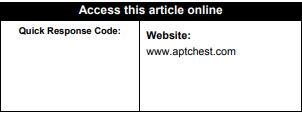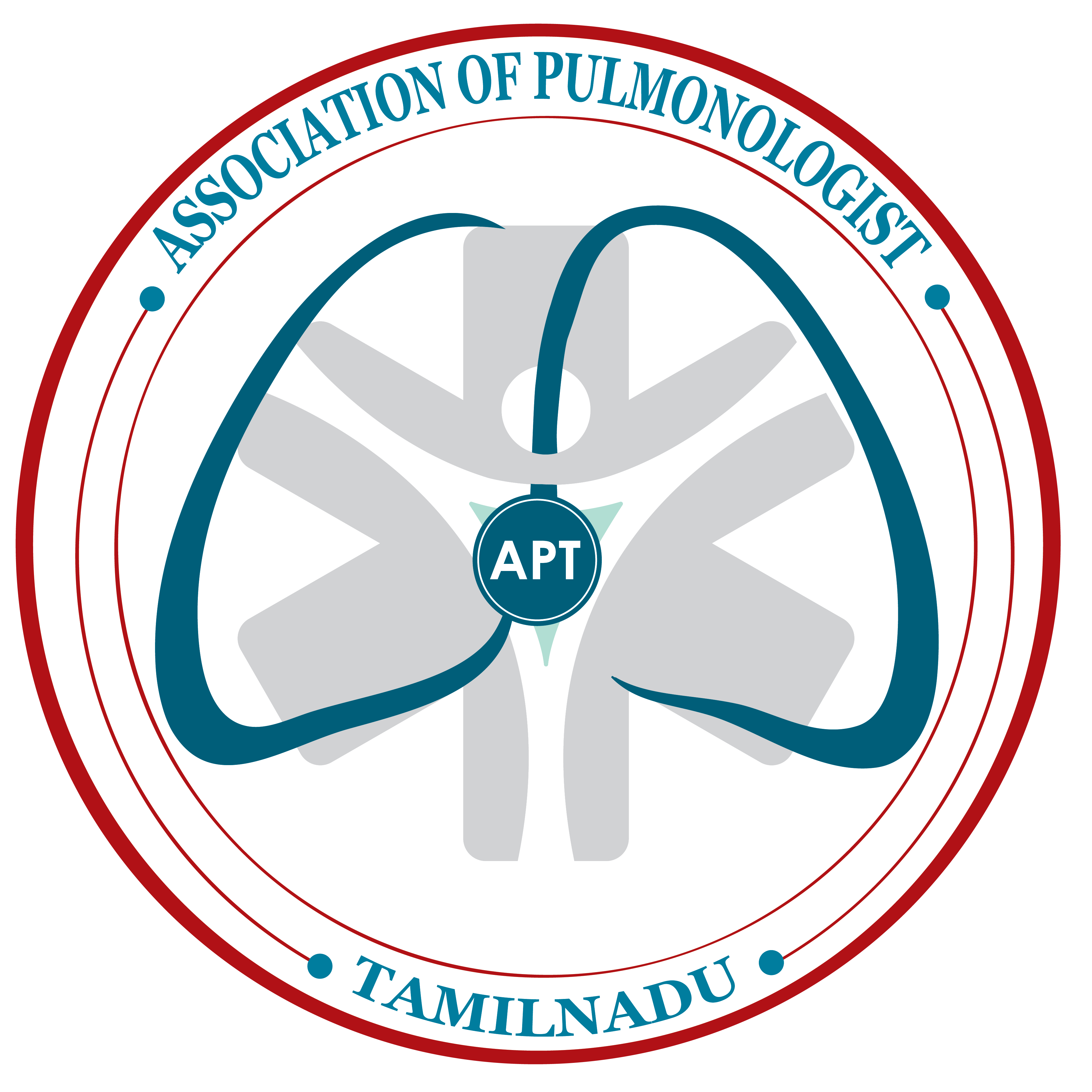RAshwin Kailash J et al.: Noisy TB- A Case of Unrecognized Coexistent Endobronchial Tuberculosis with Active Pulmonary Tuberculosis
Noisy TB – A Case of Unrecognized Coexistent Endobronchial Tuberculosis with Active Pulmonary Tuberculosis
Ashwin Kailash J1, Aruna Shanmuganathan2,Meenakshi N3 Nisha Ganga4
1Postgraduate,2Professor, 3Professor & HOD,4Senior Resident
Department of Respiratory Medicine, Chettinad Hospital and Research Institute, Kelambakkam, Chennai 603103.
Abstract
Tuberculous infection of tracheobronchial tree with histopathological and microbiogical evidence with or without parenchymal involvement is defined as Endobronchial Tuberculosis(TB). Endobronchial tuberculosis occurs most commonly in young patients between 2nd to 3rd decade with female preponderance and may present with symptoms of either the underlying disease or its complications. The diagnosis of endobronchial TB requires a high degree of clinical suspicion as chest X-ray and sputum smear may not show evidence of TB infection in majority of cases. Concurrent endobronchial involvement in patient with active TB if not diagnosed early may lead to irreversible sequelae like bronchostenosis and atelectasis. We hereby report patient who presented with atelactasis and unilateral wheeze as sequelae of unrecognized co-existing endobronchial TB with active pulmonary tuberculosis(PTB).
Keywords: Endobronchial TB, Bronchostenosis,Unilateral wheeze.
Corresponding Author: Dr. Aruna Shanmuganathan, Department of Respiratory Medicine, Chettinad Hospital and Research Institute, Kelambakkam, Chennai 603103.
How to cite this article: Ashwin Kailash J, Aruna Shanmuganathan, Meenakshi N, Nisha Ganga, Noisy TB – A Case of Unrecognized Coexistent Endobronchial Tuberculosis with Active Pulmonary Tuberculosis, JAPT 2019; 2(3):129-132
Introduction
Incidence of endobronchial TB with active PTB has been reported to range from 6% to 54% in various studies1,2. It usually presents as cough, wheeze, low grade fever, and constitutional symptoms. Chest X-ray may be normal in 10% of cases3. A negative smear for AFB and chest X-ray does not rule out the presence of endobronchial TB4. Repeat sputum CBNAAT, Bronchoscopy and CT Chest are often required to confirm its diagnosis. An early diagnosis of endobronchial TB
is essential not only for optimal treatment but also to prevent sequelae like airway stenosis, post

obstructive pneumonia, bronchiectasis. The current case highlights the sequelae of endobronchial TB that could be attributed to initial unrecognized diagnosis of co-existing Endobronchial involvement with active PTB.
Case Report
A 31 year old homemaker who was treated for smear positive pulmonary tuberculosis with the six months course of ATT in an outside centre. Though
she had completed the regular course of ATT and microbiologically declared cured, no radiological follow up was done during the entire course of
ATT inspite of persistent wheeze & breathlessness. Patient presented to us with the complaints of progressively worsening exertional breathlessness, wheeze and cough with scanty expectoration during the entire course of ATT as well as on completion of ATT.She did not have h/0 Fever/Chest pain.She was not known case of Bronchial asthma/any other obtrusive lung disease and there was no previous espiratory illnesss or significant exposure to indoor and outdoor pollution.She did not have any co-morbidites.Patient was conscious. oriented. aferbrile. tachypnoeic. No Anemia. icterus, Clubbing .cyanosis, lymph adenopathy and pedal edema. Examination of Respiratory system revealed Harsh vesicular breath sounds bilaterally with Monophonic wheeze in left infraclavicular and mammary areas.Other sysatems were clinically normal. Sputum AFB smear (Pretreatment):2+.septum CBNAAT(Post treatment)-MTB not detected.Sputum for AFB during followup & End of ATT- Negative.PFT showed mixed pattern.



Based on the above clinical and radiological findings a retrospective diagnosis of Endobronchial TB was made. Patient was medically managed with bronchodilators, mucolytics, antibiotics and chest physiotherapy. CTVS opinion was obtained in view of left upper lobe bronchostenosis with atelactasis
who advised balloon dilatation. However, patient refused to go for any interventional procedures.
Discussion
Endobronchial TB is defined as tuberculous infection which affects tracheobronchial tree. It commonly occurs in young adults with female preponderance4. However, about 15% of elderly patients may also have endobronchial TB3,5. Endobronchial Tuberculosis commonly involves right upper lobe and right main bronchus4. The exact pathogenesis of endobronchial TB is unclear. However, postulated mechanisms of infection proposed includes a) Hematogenous spread b) erosion of lymph node into bronchus c) implantation of organisms from the infected sputum d) direct extension from parenchymal
focus3. The clinical presentation of endobronchial TB is cough with expectoration, hemoptysis,breathlessness, and wheeze. Endobronchial TB is divided into seven subtypes based on bronchoscopic appearance such as 1) caseating, 2) edematous-hyperemic, 3) fibrostenotic, 4) tumorous, 5) granular, 6) ulcerative, and 7) nonspecific bronchitis2,3. Endobronchial spread of the disease may lead to complications and unfavourable response to ATT. However, a normal chest X-ray and negative smear for AFB does not exclude endobronchial pathology.
The diagnosis of Endobronchial TB can be confirmed by fibreoptic bronchoscopy and CTChest with microbiological and histopathological evidence. In active cases HRCT chest may reveal tree-in-bud appearance and centrilobular nodules, bronchial wall thickening and extent of lesio6n.In patients with sequelae HRCT chest can also identify the location and extent of sequelae for preop assessment. Bronchoscopy will aid in visualization of endobronchial lesions as well as for biopsy especially when sputum smears are
negative for AFB7,10. sequelae of endobronchial TB is managed with surgical procedures such as bronchoplasty, balloon dilatation, endobronchial
stenting8.
The concomitant presence of endobronchial TB along with active PTB was considered in our patient due to worsening clinical symptoms such as cough, dyspnea, wheeze during ATT and even on completion of entire course of ATT. Since CT chest and bronchoscopy did not showed active PTB in our patient at the end of the treatment, a retrospective diagnosis of endobronchial TB was considered in view of radiological and bronchoscopic findings. Patient was managed medically bronchodilators, mucolytics, antibiotics and chest physiotherapy. CTVS opinion was obtained in view of left upper lobe bronchostenosis with atelactasis who advised balloon dilatation, however patient refused to go for any interventional procedures.
Conclusion
This case highlights the need for high index of suspicion of endobronchial involvement in pulmonary TB with unilateral wheeze. Early recognition and management of endobronchial TB would prevent the development of its sequelae like progressive bronchostenosis and atelectasis.
References
- Jung SS, Park HS, Kim JO, et al. Incidence and clinical predictors of endobronchial tuberculosis in patients with pulmonary tuberculosis. Respirology 2015;20:488-95.
- Chung H, Lee J. Bronchoscopic Assessment of the Evolution of Endobronchial Tuberculosis. Chest. 2000;117(2):385‐392.
- Gayathri Devi HJ.Endobronchial Tuberculosis: An Overview.Avid science,chapter 1,2017.
- Aneja A, Krishnaswamy U, Thyagaraj V, Moideen R, Satya Padmaja M. Endobronchial Tuberculosis: Two Case Reports and Review of the Literature. Case Reports in Pulmonology. 2014;2014:1‐4.
- Van den Brande PM, van de Mierop F, Verbeken EK, Demedts M. Clinical spectrum of endobronchial tuberculosis in elderly patients. Archives of Internal Medicine. 1990;150(10):2105–2108.
- Kashyap S, Mohapatra PR, Saini V. Endobronchial tuberculosis. The Indian Journal of Chest Diseases & Allied Sciences. 2003;45(4):247–256.
- Ozkaya S, Bilgin S, Findik S, Kok H, Yuksel C, Atıcı A. Endobronchial tuberculosis: histopathological subsets and microbiological results. Multidisciplinary Respiratory Medicine. 2012;7(1).
- Han JK, Im JG, Park JH, et al. Bronchial stenosis due to endobronchial tuberculosis: successful treatment with selfexpanding metallic stent. American Journal of Roentgenology. 1992;159(5):971–972.
- Surendra,k Sharma, SS Dhillion, NA Hanania Endobronchial Tuberculosis second edition, chapter 16.2009;232.
- Bachh AA, Gupta R, Haq I, Varudkar GH. Diagnosing sputum/smear-negative pulmonary tuberculosis: does fibre-optic bronchoscopy play a significant role. Lung India. 2010;27(2):58–62.





